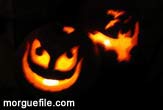Devil's Night: The History of Pre-Halloween Pranks

We all know what happens on Halloween, the night that little boys and girls dress up and (unwittingly) celebrate the ancient Celtic tradition of Samhain and All Hallows Eve.
Anyone who has woken up on Halloween morning to find their house egged, their pumpkin smashed or yard toilet-papered, however, is lucky enough to live where a sister tradition that is not quite as old (but a yearly custom all the same) is also practiced with fervor.
The night of Oct. 30, which goes by a variety of names including Devil's Night in Detroit and Miggy Night in parts of England, sees neighborhood youngsters pull pranks just as diverse as the custom's monikers, ranging from the innocent to the downright dangerous.
So where did this license to cause mayhem come from?
Mischief Night, as it is most commonly known in the United States, has been around in its present form for at least 50 years, when it became a day for playing "tricks" while Halloween itself was reserved for the little one to gather "treats." The practice goes back hundreds of years before that, though, to a time when Halloween and misbehavior were inextricably linked.
In some areas, unfortunately, today's pranks have evolved into acts much scarier than ghosts or goblins.
Mischief always a part of Halloween
Sign up for the Live Science daily newsletter now
Get the world’s most fascinating discoveries delivered straight to your inbox.
Causing mischief has been a part of the Halloween tradition since the very beginning.
The most ancient roots of Halloween come from the Celts of Great Britain, who believed that the day before their Nov. 1 New Year was a time when spirits came back to haunt and play tricks. On Oct. 31, people dressed up in scary costumes, played games, lit bonfires and left food out on their doorsteps for the ghosts in celebration of this otherworldly event, which the Celts called Samhain.
When Great Britain was Christianized in the 800s, the ghoulish games of Samhain merged with All Saints Day and All Souls Day, during which the dead were honored with parades and door-to-door solicitation by peasants for treats — usually a bit of food or money.
After the Protestant Reformation, much of England stopped the "treating" side of Halloween because it was connected to Catholic saints, and transferred the trickery to the eve of Guy Fawkes Night, a Nov. 5 holiday celebrating the foiling of the 1605 Gunpowder Plot to blow up British Parliament. Mischief Night in England is still celebrated on Nov. 4.
The Irish, Scottish and northern English, meanwhile, kept up much of their Halloween traditions, including the good-natured misbehavior, and brought their ways to North America with the wave of immigration in the 1800s.
Before the 20th century, Halloween mischief in the United States and Canada happened on Oct. 31 and consisted of tipping over outhouses, unhinging farmer's gates, throwing eggs at houses and the like. By the 1920s and 30s, however, the celebrations had become more like a rowdy block party, and the acts of vandalism more serious, probably instigated by tensions over the Great Depression and the threat of war, historians say.
To stem the vandalism, concerned parents and town leaders tried to ply kids with candy, encouraging the forgotten tradition of trick-or-treating in costume in exchange for sweets, bumping the mischief element from the celebrations of Oct. 31 altogether. It was then that the troublemakers, neighborhood by neighborhood, adopted Oct. 30 as their day to pull pranks. Rotten vegetables
The custom of vandalism on Oct. 30, oddly, seems to have only developed sporadically, often appearing in some areas but not at all in others nearby.
Nowadays, Mischief Night is especially popular in pockets where Irish and Scottish immigration was common — in northeastern United States but not in the South and West, for example, and in the English-speaking communities of Canada but not the French. Examples of the regional varieties include:
- Cabbage Night in parts of the northeastern United States, where rotten vegetables are collected and left on porch stoops or smeared on doors and windows.
- Mat Night in English-speaking Quebec, where pranksters steal doormats and switch them with the neighbors'.
- Gate Night, in the Midwest, where farmers gates are opened, leaving livestock to roam free.
Other popular pranks include the ubiquitous toilet-papering of homes and trees, "soaping" cars and windows and pumpkin smashing.
Though it consists of harmless fun in most places, "Devil's Night" in Detroit is notorious for its ties to gang culture and random acts of arson.
In 1984, more than 800 fires were set there on Devil's Night, leading to a serious crackdown and an Oct. 30 curfew for minors that persists to this day. This year, the mayor of Detroit has recruited an army of more than 30,000 volunteers to patrol their neighborhoods to prevent any similar mayhem.











